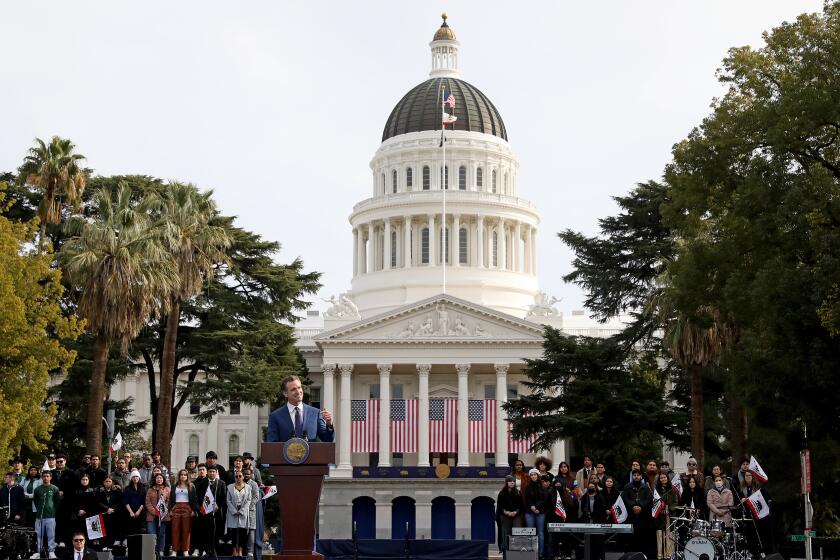Big Plans, Little Money for Car-Pool Lanes : Freeways: Caltrans unveils $6.2-billion proposal, but officials say it clashes with economic realities.
- Share via
On the eve of crucial budget deliberations, Caltrans officials unveiled an ambitious $6.2-billion program Tuesday to add car-pool lanes to virtually every Los Angeles County freeway.
There is, however, one catch: There is no assurance that the money will be there to pay for it.
“Good luck!” said Glendale Mayor Larry Zarian, a board member of the Metropolitan Transportation Authority, which will meet today to hammer out the agency’s budget. “The $6.2 billion is wishful thinking.”
Zarian and others say the ambitious Caltrans program clashes with harsh economic realities. Because of the state’s fiscal problems, Caltrans must depend on the MTA to finance the diamond lanes. But the MTA also faces a $2.9-billion shortfall over the next 10 years and must grapple with competing priorities, such as the proposed Pasadena rail line.
Diamond lanes have never done well in Los Angeles, a place where congestion is so notorious that a traffic reporter won a star on the Hollywood Walk of Fame. But this time, with drivers fed up by their commutes, Caltrans officials believe that they will win the MTA’s approval and that the car-pool lanes will win public acceptance.
Jerry Baxter, Caltrans director for the Los Angeles district, said he believes that the car-pool program will proceed--despite a recent effort to divert $193 million from Caltrans for use on the Pasadena rail line.
“Reasonable people usually make good investments,” Baxter said. “It really is our single hope of coping with travel growth in the region.”
The car-pool program, which would require $350 million for design and construction in the next four years, represents yet another bid by the agency to win over Angelenos to the car-pool concept.
Seventeen years ago, a car-pool lane, with freshly painted white diamonds adorning the blacktop, was established on the Santa Monica Freeway. The noble experiment quickly turned into a traffic engineer’s worst nightmare as the roadway became jammed and irritated drivers launched vituperative opposition.
In that case, traffic engineers made a key mistake when they deprived drivers of one normal-use lane and converted it into a car-pool lane. Now, they say, Caltrans has learned its lesson.
Under the new plan, the existing 12-foot-wide lanes would be narrowed to 11 feet and the 11-foot freeway median would be used to create an additional lane.
Two sets of double yellow lines would separate car-pool lanes from the regular lanes. And the outside shoulder would be unaffected by the reconfiguration of the freeways, Baxter said. To diminish traffic snarls, Caltrans would do much of the work at night.
But the plan has already drawn fire from critics who question the safety of narrower lanes.
“It’s bad news for drivers,” said Gerald A. Silver, president of Homeowners of Encino, a nonprofit property owners group. “I do not oppose high-occupancy vehicle lanes if it’s done safely. But you cannot get rid of the median nor reduce lanes down from federal standards. . . . And it must be separated by more than double yellow lines--I don’t want to be driving my car in that type of situation; it’s too dangerous.”
Federal regulations call for 12-foot-wide lanes on freeways and highways. To implement its plan, Caltrans received a waiver from the regulations, said Raja Mitwasi, chief of Caltrans’ high-occupancy vehicle (HOV) branch.
Across the nation, more and more states are trimming the widths of regular traffic lanes so car-pool lanes can be added. Although federal officials say the trend does not pose added dangers, they acknowledge that there is a trade-off for drivers and traffic engineers.
“There’s always a compromise any time you are trying to improve the traffic flow by adding HOV lanes. You do a trade-off by using 11-foot lanes against 12-foot lanes and you get the ability to move more people and more cars,” said Tom Willett, director of the office of engineering with the Federal Highway Administration in Washington.
The current Caltrans 30-year plan calls for construction of about 265 miles of car-pool lanes--which would cost $6.2 billion. Most of the money for the project would come from the sales tax surcharge, Proposition C, which finances local transportation programs, Baxter said.
But because of a downturn in the economy, MTA officials realized this spring that they have more projects on the books than money to pay for them. As a result, they said, Caltrans would probably be granted its immediate request of $350 million but not the entire $6.2 billion needed for the entire program.
“That $6.2 billion will most likely be adjusted. I can’t tell you what that number will go down to, but it will be reduced, given the sales tax shortfalls,” said Linda Bohlinger, the MTA’s director of capital planning.
Pending the MTA’s approval, Caltrans will use the requested $350 million to pay for the design and construction of car-pool lanes. About $315 million of that will pay for construction of the lanes, running in both directions, on 100 miles of Los Angeles freeways.
The highways that are scheduled for car-pool lanes include: the Pomona Freeway from the Orange Freeway to the county line, the Simi Valley Freeway from the Golden State Freeway to the county line, the entire Ventura Freeway, the San Diego Freeway from the Long Beach Freeway to the Pasadena Freeway, and from the Ventura Freeway to the Golden State.
The Car-Pool Plan One day before crucial budget diliberations, Caltrans officials unveiled their ambitious $6-billion car-pool lane program. Only 80 miles of car-pool lanes have been funded so far. They hope to obtain funding for another 165 miles, which would enable them to install car-pool lanes on virtually every Los Angeles freeway.
More to Read
Sign up for Essential California
The most important California stories and recommendations in your inbox every morning.
You may occasionally receive promotional content from the Los Angeles Times.










